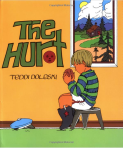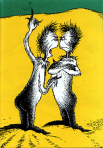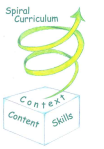by schoolcounselingbyheart | Apr 8, 2012 | Aspergers, autism, children's literature, classroom lessons, social thinking
 The kids at my school are generally pretty accepting and understanding about their classmates’ learning differences and disabilities. They offer to help when appropriate, and are good about including others. They know the names of all the kids with significant disabilities, greet them in the hall and their classrooms, and some even volunteer to work with them. We spend a lot of time talking about how everyone learns differently, that we all have things that make us different, and that none of us likes to be picked on or excluded. They are usually patient about disruptive behaviors, especially if the student’s disability is obvious and/or a paraprofessional works with the student.
The kids at my school are generally pretty accepting and understanding about their classmates’ learning differences and disabilities. They offer to help when appropriate, and are good about including others. They know the names of all the kids with significant disabilities, greet them in the hall and their classrooms, and some even volunteer to work with them. We spend a lot of time talking about how everyone learns differently, that we all have things that make us different, and that none of us likes to be picked on or excluded. They are usually patient about disruptive behaviors, especially if the student’s disability is obvious and/or a paraprofessional works with the student.
The difficulty comes when a not-so-obvious disability is combined with repetitive, disruptive or annoying behaviors (more…)
by schoolcounselingbyheart | Mar 27, 2012 | children's literature, classroom lessons, personal safety
 What happens when you keep your hurt feelings bottled up inside? The hurt deepens and festers. It gets bigger. This is the premise of The Hurt by Teddy Doleski. When Justin gets called a name, he doesn’t tell his friend how he feels or tell his dad what happened. Instead he just sits with his hurt, which looks like a rock, feeding it with his worries and disappointments until it gets so big that it takes up his whole room. The hurt finally starts to shrink and eventually goes away when Justin talks to his dad about it. The Hurt is a great book to share with individuals, in small groups, and in the classroom. It provides (more…)
What happens when you keep your hurt feelings bottled up inside? The hurt deepens and festers. It gets bigger. This is the premise of The Hurt by Teddy Doleski. When Justin gets called a name, he doesn’t tell his friend how he feels or tell his dad what happened. Instead he just sits with his hurt, which looks like a rock, feeding it with his worries and disappointments until it gets so big that it takes up his whole room. The hurt finally starts to shrink and eventually goes away when Justin talks to his dad about it. The Hurt is a great book to share with individuals, in small groups, and in the classroom. It provides (more…)
by schoolcounselingbyheart | Mar 18, 2012 | classroom lessons, conflict resolution, group counseling, individual counseling
 Zax are terrible role models for how to solve conflicts! But their story, “The Zax,” by Dr. Seuss, is a great way to start a discussion about conflict resolution. The zax are two single-minded characters, one who wants to go north, and the other who wants to go south. When they meet face-to-face on the north-south path, neither one will budge. At all. Ever. End of story.
Zax are terrible role models for how to solve conflicts! But their story, “The Zax,” by Dr. Seuss, is a great way to start a discussion about conflict resolution. The zax are two single-minded characters, one who wants to go north, and the other who wants to go south. When they meet face-to-face on the north-south path, neither one will budge. At all. Ever. End of story.
I use “The Zax” to introduce my conflict resolution unit because it perfectly illustrates what happens when you don’t use conflict resolution strategies. (more…)
by schoolcounselingbyheart | Mar 10, 2012 | bullying, children's literature, classroom lessons, curriculum
 In my previous post, I outlined how I used a comprehensive counseling approach to address a first grade bullying situation through classroom teaching, small groups, and individual counseling. (Read about it here.) In this and upcoming posts, I’ll share the lessons from the new first grade bullying unit I developed. (Related ASCA standards are listed at the end of this post.) The objective for the bullying unit was:
In my previous post, I outlined how I used a comprehensive counseling approach to address a first grade bullying situation through classroom teaching, small groups, and individual counseling. (Read about it here.) In this and upcoming posts, I’ll share the lessons from the new first grade bullying unit I developed. (Related ASCA standards are listed at the end of this post.) The objective for the bullying unit was:
When students experience or witness bullying they will be able to:
- differentiate between mean and bullying behaviors.
- recognize that bullying should be reported to school staff.
- use a script to report bullying to school staff.
- tell another school staff member if the first adult does not believe or understand the report. (more…)
by schoolcounselingbyheart | Mar 7, 2012 | assessment, children's literature, classroom lessons, group counseling
 Looking for a way to expand upon what you’re able to teach in your limited time in the classroom? Wondering about how to assess your students’ learning at the end of a unit? Book studies can help you do both.
Looking for a way to expand upon what you’re able to teach in your limited time in the classroom? Wondering about how to assess your students’ learning at the end of a unit? Book studies can help you do both.
Book studies can be used for a variety of topics: conflict resolution, bullying, responsibility, differences/diversity, friendship, emotional literacy, etc. All you need is (more…)
by schoolcounselingbyheart | Mar 4, 2012 | bullying, classroom lessons, curriculum

Last week the counselors in my district were asked to present information on how bullying is addressed in each of our schools, and I thought it might be helpful to highlight some of what my counseling partner, Erica, and I shared.
We start from the premise that bullying, bystander, and target behaviors are often a result of lagging skills in the areas of empathy, problem solving, conflict resolution, social thinking, self-monitoring, and/or self-advocacy. To build kids’ skills, we teach a developmental, spiraling bullying prevention curriculum K-5. For each grade, bullying is defined in a way that is (more…)
 The kids at my school are generally pretty accepting and understanding about their classmates’ learning differences and disabilities. They offer to help when appropriate, and are good about including others. They know the names of all the kids with significant disabilities, greet them in the hall and their classrooms, and some even volunteer to work with them. We spend a lot of time talking about how everyone learns differently, that we all have things that make us different, and that none of us likes to be picked on or excluded. They are usually patient about disruptive behaviors, especially if the student’s disability is obvious and/or a paraprofessional works with the student.
The kids at my school are generally pretty accepting and understanding about their classmates’ learning differences and disabilities. They offer to help when appropriate, and are good about including others. They know the names of all the kids with significant disabilities, greet them in the hall and their classrooms, and some even volunteer to work with them. We spend a lot of time talking about how everyone learns differently, that we all have things that make us different, and that none of us likes to be picked on or excluded. They are usually patient about disruptive behaviors, especially if the student’s disability is obvious and/or a paraprofessional works with the student.




